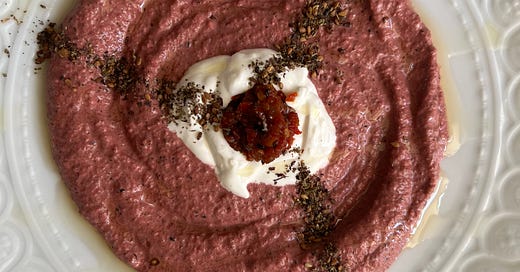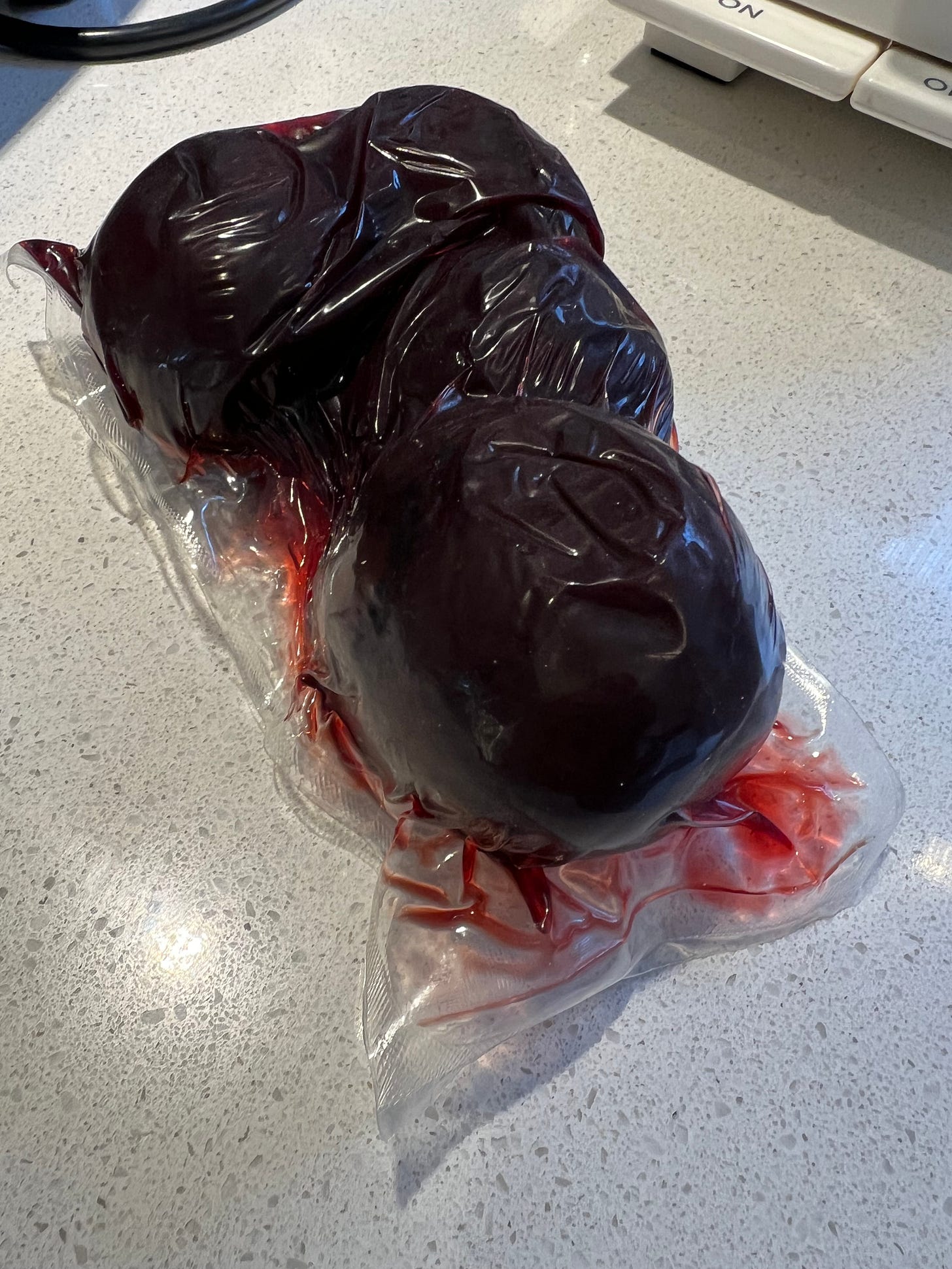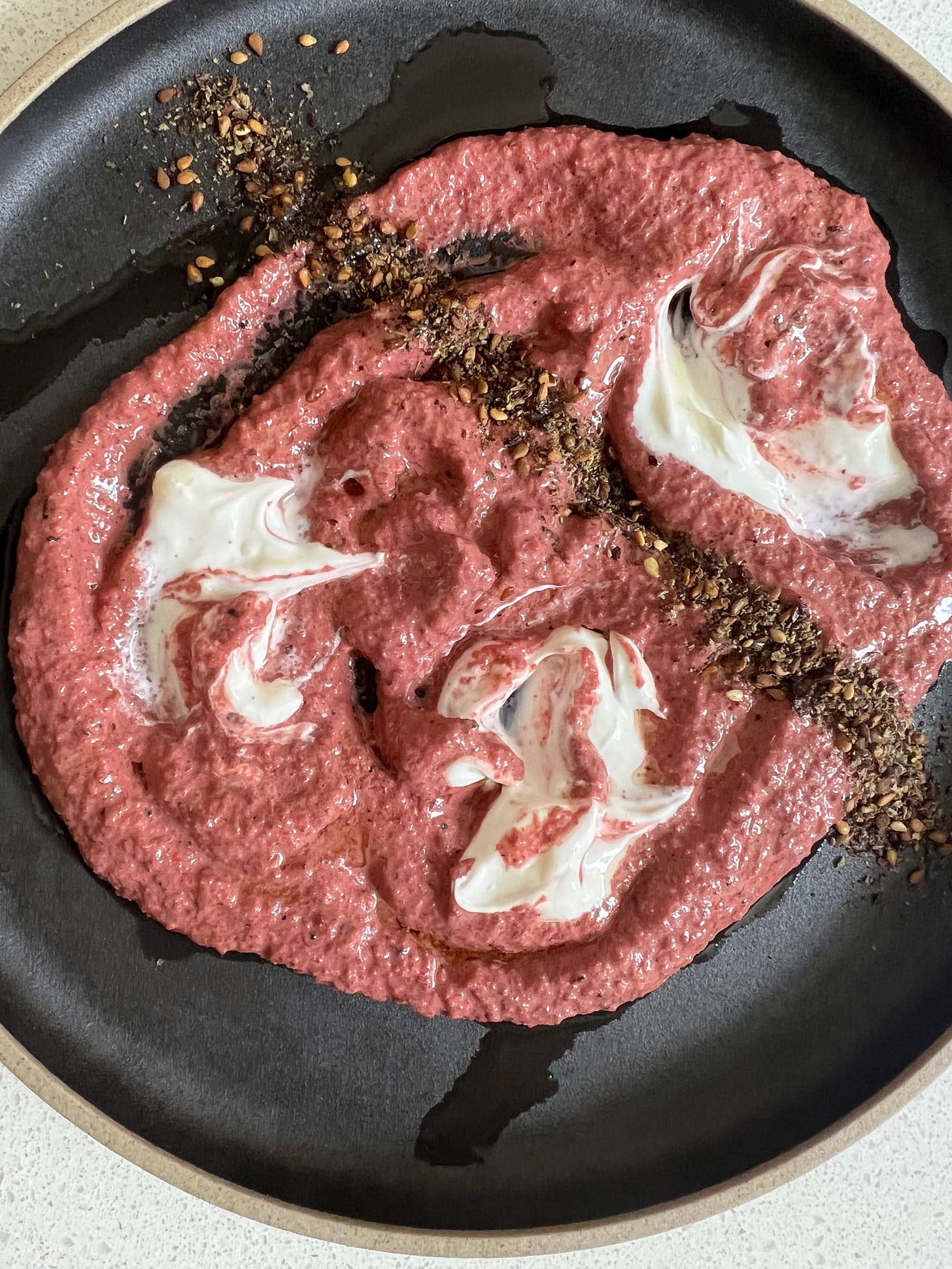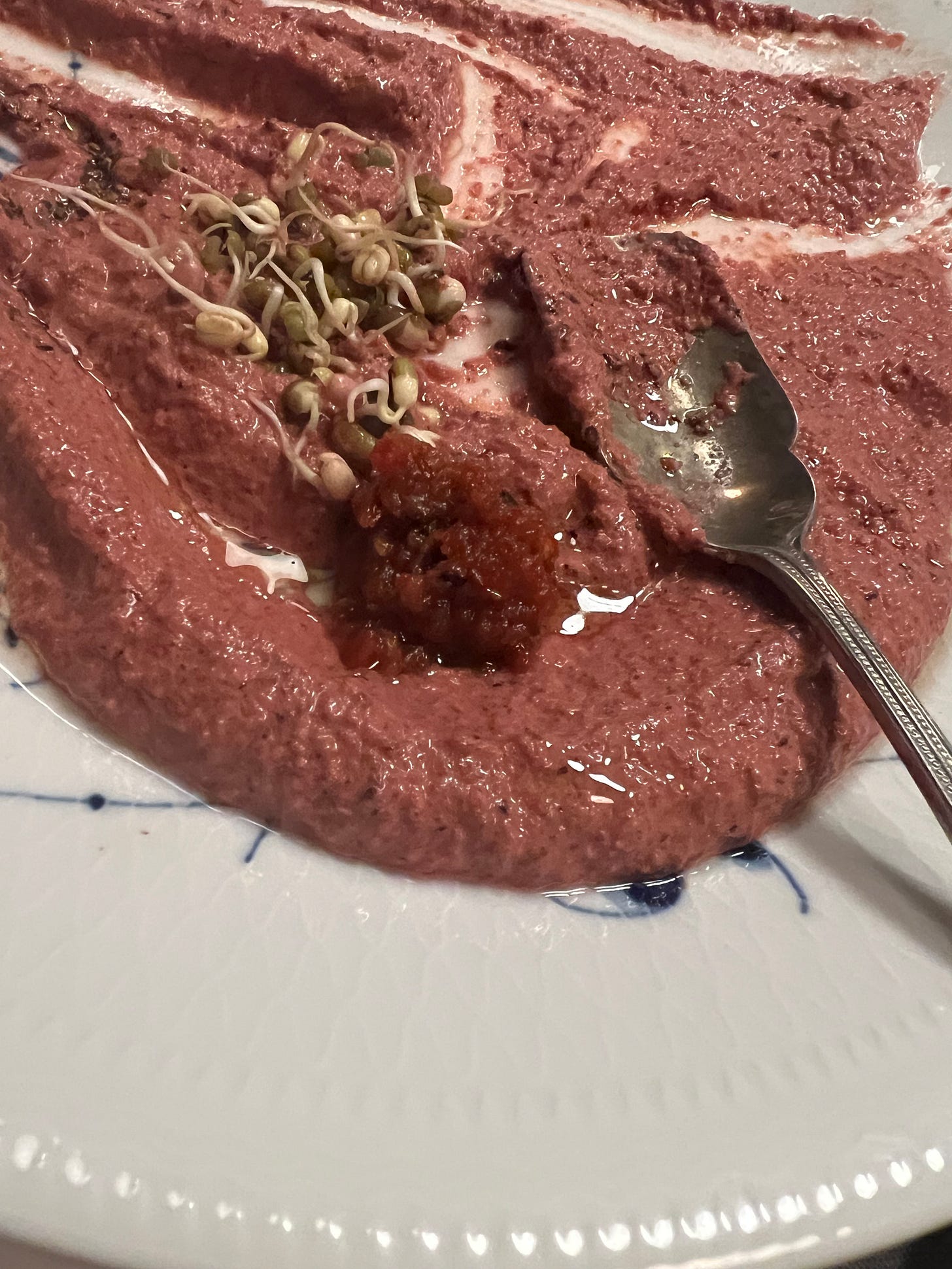Issue #94: The Beet Is On
Listen to Celebrated Winemaker Paul Hobbs, Thoughts On Produce Prep and Cooking Convenience, Recipe for Beet Hummus with Za'atar
In the world of wine there are some people so famous they have a cult following. People watch closely what they do and try to snatch up everything they produce before it is released. Outside that world, their names may not even ring a bell. Paul Hobbs is one such winemaker, whose magic touch in his vineyards and in his wineries on four continents has earned him perfect scores so often he falls into this rare cult echelon. Paul and I met in the Finger Lakes at the opening of his latest venture, Hillick and Hobbs. And for this week’s episode of What’s Burning I spent an hour chatting with him about the state of winemaking, what it takes to make a great wine, and what culinary professionals can learn from the patience and perseverance required to turn grape juice into gold. —Mitchell
I started writing this newsletter on the first day of spring. It was beautifully sunny in New York City, but deceptively cold. Culinarily, this is the time of year when the wintered produce feels old and tired and there’s nothing new yet from the season. I think it’s hilarious when on the first warm day of spring (this winter we saw several days over 60°F. so we are way ahead of the calendar) everyone shows up at the Union Square Greenmarket looking for local produce, as though it might bolt through the frozen ground overnight. We are still weeks away from ramps and rhubarb. Chillax people!
So, what to cook? Of course, the supermarkets are always flush with flora from around the world. But I’m forever reminded how inferior these out-of-season things taste. Last week I bought impressive-looking blueberries from Peru the size of small plums that had so little taste I checked the label to make sure I hadn’t misread what they were supposed to be.
A recent article in the New York Times used the Japanese strawberry story to expose the environmental cost of forcing out-of-season fruit. (I’d always wondered how and why strawberry shortcake was a Christmas tradition in Japan, and never considered they had actually moved the season.) While I take issue with the Times’s constant orientalist harping on the eccentricities of Japanese culture, as though everything we do here makes perfect sense, I was interested to learn how, through fossil-fuel-guzzling greenhouses, the Japanese have made strawberry season a feature of winter to the point that no one eats them in warmer months. What is further remarkable is that they manage to get good flavor out of that out-of-season fruit. So, we know it is possible, but at a tremendous cost, both in terms of carbon footprint and price.
Our friend, Karen, a restaurateur from the Finger Lakes, was staying with us last weekend and I wasn’t sure what to make for dinner. (See Karen’s schnitzel recipe in Issue #90.) There certainly wasn’t much inspiration in the greenmarket. Then, at our neighborhood Korean deli, I spotted a package of organic, steamed, peeled, vacuum-sealed beets. I’d start there.
Ever since I lived in Paris back in 1989 and then in Italy on occasion, I’ve wondered why American grocers didn’t sell more ready-to-cook items, like these vacuum-packed beets that were commonplace over there. At street markets in Italy you find cooked beets, roasted onions, pre-soaked baccala, ready to use in the kitchen. In Spain, I love the bean shops that display beautiful bowls of freshly cooked beans, no cans in sight. In Thailand the prepped fruit sold on the street is my jam. In Sichuan, the pickle shops that dotted shopping districts blew my mind (and my tastebuds).
Sure, these days you can buy some fruit and vegetables already peeled and cut up at American grocery stores. But pre-cutting isn’t great for some vegetables, which can oxidize, and therefore require preservatives. What’s more, these items are usually prepared in some giant commercial facility thousands of miles away, rather than in some local shop, from local produce, as needed. If they are made locally, they often begin with inferior or unripe produce. Convenience trumps quality. More than once I’ve been seduced by bags of shelled peas at Trader Joes they taste more like tiny green potatoes. To make the misticanza (Italian for mesclun) that my neighobrhood produce shop in Milan sold, they would reach for a head of lettuce, a radicchio, some other greens, and toss them together into a large basin as needed. I was in salad heaven.
When the first Eataly opened in New York just down the street from us, they announced a new staff position, “Vegetable Butcher,” which I thought was genius. Someone on site was there to prep the beautiful produce you just picked up. I don't think the post lasted long, but Eataly continues to sell a variety of produce prepped daily on site. And their prices are surprisingly competitive.
Don’t’ get me wrong. I’m not at all opposed to convenience when it comes to cooking. Not everyone has as much time or desire to be in the kitchen as I do. But convenience doesn’t have to be canned or chemically assisted. While I am not opposed to mass-production in theory, I am opposed to manipulation and processing that is often marketed as being for our benefit, but almost always just makes things more economical for the producer, the processor, the distributor, and all the other middlemen inn the food supply chain. Taste is almost never their concern.
Anyway, back to the beets, which although organic, I realize fell into the mass-produced category. After all, they were for sale in early March at a bodega in New York City. Still, they were certified organic and seemed seasonally appropriate. The label had only one ingredient, “beets.”
Not Your Ho-Hum Hummus
To add a little sunshine and warmth to the weekend, I settled on a Middle Eastern menu for dinner with Karen, and I decided to start with an old favorite of mine, beet hummus, the recipe for which I am sharing with you today.
Although hummus is one of the unofficial national dishes of Israel, where I’ve been spending some time for work lately, it’s unusual for chefs to mess around with it too much. Here, we call hummus just about anything we puree into a spread, whether with chickpeas or other legumes or without. (Similarly, we call every herb paste a pesto, even though in Italy the term is reserved for a very limited number of variations.)
I like to make hummuses (the spelling is correct, but it looks weird) from many things, including roasted butternut squash (see Issue #19) and beets. This recipe was inspired by one in Yotam Ottolenghi and Sami Tamimi’s seminal Jerusalem cookbook. But I’ve changed it quite a bit over the years to home in on both the flavor and texture I’m looking for.
Technique: Cooking Beets
If you can find already cooked beets as I described above, great. (But don’t use canned for this recipe, which won’t work.) If you intend to cook your own beets, I’ll let you in on a secret that I learned from my friends in Maine few years back. That Insta-pot (or any pressure cooker) collecting dust in your cupboard is the best beet-cooking machine out there. You can cook pounds and pounds of beets perfectly in 20 minutes or less, depending on their size. Just wash them, put about an inch of water in the bottom of the pot. Set in a steaming rack and pile in the beets. Bring the pressure up to high and cook for 15 minutes (for small to medium beets) to 20 minutes (for medium to large beets). You can let the cooker cool naturally or speed it up under cold, running water. When cool enough to handle, peel the beets and use them in this or any recipe that calls for cooked beets.
Alternately, you can roast your beets, which further concentrates their flavor. Wash them, don’t peel, but wrap them well in aluminum foil. Set in a 400°F. oven and roast until soft when poked with the tip of a knife. This can take anywhere from 75 minutes to two hours, depending on the size and age of your beets. If your beets are of widely varying sizes, remove smaller ones when they are soft, reseal the foil package, and continue roasting until the larger ones are done. Let them cool in the package, and then peel.
Recipe: Beet Hummus with Labne and Za’atar
(Makes about 3 cups)
1 pound cooked, peeled beets (from about 2 pounds raw)
2 cloves garlic, peeled and minced
1 fresh serrano or other chili, seeded and chopped, or a generous pinch of mild ground chili, such as Kashmiri chili or gochugaru
½ cup labne or whole-fat Greek yogurt, plus more for garnish
2 heaping tablespoons tahini
1 tablespoon extra-virgin olive oil, plus more for garnish
Juice of ½ lemon
1 tablespoon pomegranate molasses or date syrup, plus more for garnish
1 tablespoon za’atar, plus more for garnish
½ teaspoon fine sea salt
Fresh cilantro, toasted nuts and/or seeds, fermented chili sauce, or whatever you’d like, for garnish
In the bowl of a food processor fitted with a metal chopping blade, combine the cooked beets, garlic, chili, labne, tahini, olive oil, lemon juice, pomegranate molasses or date syrup, za’atar and salt. Pulse until the beets have been ground down somewhat, and then let the machine run until you have a smooth purée. Taste and adjust the seasoning with more sweet, sour, or salt, as desired.
To serve, you can use a wide bowl or flat plate. I like to spoon the hummus in the center and then spread it out to fill the dish using a spatula or the back of a spoon in a circular motion, leaving hills and valleys to hold the garnishes. Dot with dabs of labne, a drizzle of olive oil and/or pomegranate molasses, a sprinkle of zaatar, or whatever else you have to make it pretty and delicious. Serve with fresh pita (Issue #43) or other bread.







